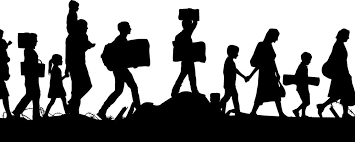Migration
"Migration Patterns and Trends: A Comparative Analysis"
Migration refers to the process of movement of individuals, groups, or populations from one place to another, often involving a change in their residence or habitat. This movement can be within a single country (internal migration) or across international borders (international migration). Migration can be influenced by a wide range of factors, including economic opportunities, social and political conditions, environmental changes, conflict, and personal aspirations.
There are several types of migration, each with its own characteristics:

International Migration: This type of migration involves crossing international borders and often requires legal processes such as obtaining visas or seeking asylum. It can be driven by factors like economic prospects, family reunification, or the need to escape conflict or persecution.
Voluntary Migration: This occurs when individuals or groups choose to move due to perceived opportunities, better living conditions, or personal preferences. Economic factors, education, and improved quality of life are common motivations.
Forced Migration: Also known as involuntary migration, this occurs when individuals are compelled to move due to threats to their safety, such as conflict, persecution, or environmental disasters. Refugees and internally displaced persons (IDPs) fall into this category.
Seasonal Migration: Some individuals or groups move temporarily for specific reasons, such as agricultural work during planting and harvest seasons. This type of migration is often cyclical and can involve crossing regional or national borders.
Transnational Migration: This involves individuals maintaining connections and activities in both their country of origin and their host country. It often includes regular travel back and forth and can lead to the creation of diaspora communities.
Labor Migration: People move to seek employment opportunities in regions or countries where there is a demand for their skills or labor. This type of migration contributes to economic development but can also present challenges related to labor rights and social integration.
Migration has significant social, economic, and cultural implications for both the migrants and the communities they leave and join. It can lead to cultural exchange, diversification of societies, and the transfer of skills and knowledge. However, migration can also present challenges related to social integration, discrimination, xenophobia, and strain on resources.
Understanding the causes, patterns, and consequences of migration is crucial for policymakers, researchers, and organizations aiming to create effective migration policies, support migrants' well-being, and address the broader impact of migration on societies and economies.
Migration refers to the process of movement of individuals, groups, or populations from one place to another, often involving a change in their residence or habitat. This movement can be within a single country (internal migration) or across international borders (international migration). Migration can be influenced by a wide range of factors, including economic opportunities, social and political conditions, environmental changes, conflict, and personal aspirations.
There are several types of migration, each with its own characteristics:

Internal Migration: This type of migration involves movement within a country's borders. It can be rural-to-urban migration (from rural areas to cities), urban-to-rural migration (from cities to rural areas), or movement between different urban areas.
International Migration: This type of migration involves crossing international borders and often requires legal processes such as obtaining visas or seeking asylum. It can be driven by factors like economic prospects, family reunification, or the need to escape conflict or persecution.
Voluntary Migration: This occurs when individuals or groups choose to move due to perceived opportunities, better living conditions, or personal preferences. Economic factors, education, and improved quality of life are common motivations.
Forced Migration: Also known as involuntary migration, this occurs when individuals are compelled to move due to threats to their safety, such as conflict, persecution, or environmental disasters. Refugees and internally displaced persons (IDPs) fall into this category.
Seasonal Migration: Some individuals or groups move temporarily for specific reasons, such as agricultural work during planting and harvest seasons. This type of migration is often cyclical and can involve crossing regional or national borders.
Transnational Migration: This involves individuals maintaining connections and activities in both their country of origin and their host country. It often includes regular travel back and forth and can lead to the creation of diaspora communities.
Labor Migration: People move to seek employment opportunities in regions or countries where there is a demand for their skills or labor. This type of migration contributes to economic development but can also present challenges related to labor rights and social integration.
Migration has significant social, economic, and cultural implications for both the migrants and the communities they leave and join. It can lead to cultural exchange, diversification of societies, and the transfer of skills and knowledge. However, migration can also present challenges related to social integration, discrimination, xenophobia, and strain on resources.
Understanding the causes, patterns, and consequences of migration is crucial for policymakers, researchers, and organizations aiming to create effective migration policies, support migrants' well-being, and address the broader impact of migration on societies and economies.
Visit: https://bestpaperaward.blogspot.com/
#MigrationPolicy
#RefugeeSupport
#IntegrationJourney
#MigrationAwareness
#MigrantAdvocacy
#TransnationalLiving
#MigrationImpact
#MigrationChallenges
#MigrationSolutions
#MigrationInclusion
#MigrationJustice
#MigrationPolicy
#RefugeeSupport
#IntegrationJourney
#MigrationAwareness
#MigrantAdvocacy
#TransnationalLiving
#MigrationImpact
#MigrationChallenges
#MigrationSolutions
#MigrationInclusion
#MigrationJustice
Facebook: https://www.facebook.com/profile.phpid=100087106114908
Twitter : https://twitter.com/bestpaperaward
Pinterest : https://in.pinterest.com/bestpaperaward
Linkedin : https://www.linkedin.com/in/esha-gupta-18b2b4245
Instagram: https://www.instagram.com/eshagupta__2022/
Twitter : https://twitter.com/bestpaperaward
Pinterest : https://in.pinterest.com/bestpaperaward
Linkedin : https://www.linkedin.com/in/esha-gupta-18b2b4245
Instagram: https://www.instagram.com/eshagupta__2022/



Comments
Post a Comment